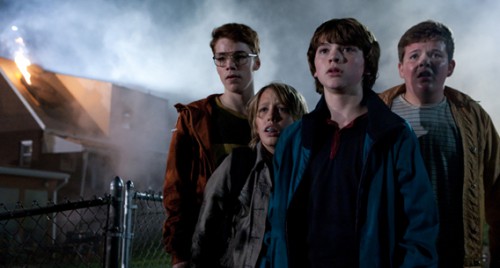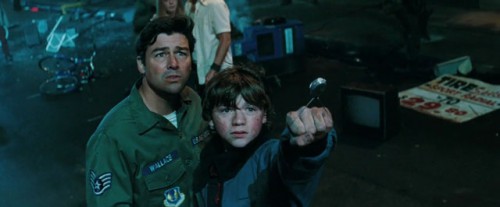ALLEGORICAL COMPLEXITY #1 (CONTINUED)
So… How is the alien most like a Jew? Or rather, what is it that allows you to identify the alien as a disguised Jew in the first place? But then how, equally, is the alien least like a Jew? And what kind of unlicensed fantasy (about Jews) does that discrepancy announce? We can now ask those questions about Super 8. But before we do so, we’ll want to work out the character of its debt to Steven Spielberg. Everybody said the movie owed a lot Spielberg, and they were right, though maybe not as right as they thought. Super 8 does indeed commandeer the stunted bike from ET and the boy-adventurers from The Goonies. The actor in the lead role does look an awful lot like Henry Thomas. There’s a hefty kid. It’s not just Spielberg, though. Super 8 owes money all over town—owes something to Romero and the ‘70s-era zombie film; owes something else again to the sci-fi monster movies of the ’50s and ‘60s. We can think of the movie as counting off the decades or as constructing its own cinematic timeline, and this in turn points to a small struggle internal to the ongoing history of retro culture. The Spielberg (and Lucas) movies of the late ‘70s and early ‘80s elected as their own precursors and retro-models the adventure films of the ‘30s and ‘40s: old Westerns, serials, swashbucklers, Buck Rogers, movies with dirigibles. But JJ Abrams is trying to wrench Spielberg’s corpus from its own chosen roots in order to then insert it into the different, more recent history of the movies that he prefers. The year 1980 is no longer, in the first instance, locked into a historical constellation with World War II, as it was with ET; our own 2011, rather, is locked into a constellation with 1980, which—‘50s, ‘60s, ‘70s—is now just another year in the post-war.
And yet Abrams’s politics are in some fairly precise way still Spielberg’s own: different historical coordinates, same ideological program. The movie puts on display the doctrine of heroic liberalism, in which the boy-sentimentalist emerges as the better man—not just morally superior, but more efficacious, succeeding precisely where the bullies and badasses fail. This much becomes clear even in a plot summary: The Air Force has had a large alien creature in its custody for more than twenty years (in order to study it and because the government wants the alien’s technology). One discharged military scientist, however, wants to set the alien free because he knows it is not the enemy—all it wants is to leave the planet. The movie is thus at once Godzilla and Spielberg’s goose-necked cuddly toy, which is to say that Super 8’s monster plays like a cornered, riled, amok-running ET: Mothra phone home…. The creature rampages around rustbelt Ohio, swatting down the people who want to capture or attack it, and yet—and here’s the key—it does not kill indiscriminately. The creature stops itself from mauling the town’s children when it comes face to face with them, and not just because they are children, but rather because it is psychic, an empath, and it recognizes that the main character—the 12- or 13-year old kid—is compassionate. It doesn’t flatten the boy because it recognizes that he is not an aggressor. We’ll want to note, too, that the movie has given our hero an extensive backstory to explain how he attained the sympathetic wisdom that rescues him: His mother, working in a steel mill, was crushed in a factory accident. That experience has made him quick to spot the sorrow of others. And from out of the reserves of his grief, he says something like: “I know bad things happen. You can still live.”
Super 8 is a useful film, not least in that it reveals how much magical thinking is involved in this version of liberalism. Fellow-feeling is the amulet that wards off attack. And this is where it becomes important to specify the allegory—to identity the real-world referents that accrue around the monster. We’ll want to ask: Which conflicts exactly does the movie think that a kindhearted and downbeat liberalism can resolve? This is a little tricky, in that the movie is operating in two political registers at once, and they don’t line up, not neatly, at any rate. First, in the military sequences, it turns out that the Air Force is as out of control as the monster itself, unable to stabilize the situation, torching the Midwestern town it has covertly come to occupy. It reduces homes to cinders, but is vulnerable to attack when traveling the roads, &c. This, of course, is all War on Terror imagery—or specifically Iraq War imagery of a pre-Surge vintage. The monster is to that extent framed as an Iraqi insurgent or perhaps more generically as an enraged Muslim, since allegories often drift unpredictably across taxa or levels of abstraction, from genus to family—that’s another of their complexities. But then it’s not just political Islam: Other scenes in the movie introduce what is basically a civil-rights language. The boy-detectives discover documentary footage of early Air Force experiments on the creature, and the movie specifies that the reels date from 1963, and the one dissenting military officer in the footage—the one who wants to spring the monster loose—keeps saying things like We shouldn’t be holding it captive … we shouldn’t fear it … it just needs our understanding … this isn’t right. That the military officer is also black puts the seal on the allegory: A black man in the early ‘60s is asking others in the government to reform their policies—to trade in a politics of repression for a politics of recognition. And it is within this framework—with regard to the racial politics of the American mid-century—that the movie’s few references to King Kong do their hardest work: The monster makes off with a pretty blonde; the monster scales a water tower and looks down over the town. Quentin Tarantino was right. The other name for Kong is “the history of the American Negro.”
So the monster is aligned both with aggrieved Muslims and with ‘50s-era black Americans, which produces a kind of allegorical master category, something like, people the US government has done dirt by, which at this point is a pretty large set. If we now add in the movie’s insistent references to ET, then we have to conclude that the movie is referring both of those histories analogically back to the Holocaust—the monster is the imprisoned Muslim in the guise of Emmett Till in the guise of Anne Frank—and the master category therefore becomes broader still: victims of racist violence at the hands of white Christians. From genus to family and now on to order and class.
But the presence of ET in this potage of intertext not only expands the movie’s range of possible meanings. It also sabotages them. It is at this point that we have to ask: How is the monster least like a Muslim or a black American? And the answer to that question is ready to hand. The liberals in Super 8 are the ones who understand that the monster just wants to go home. But what would it mean to say that about either scenario?—the civil rights scenario or the Muslim one? Black people in America do not, in the relevant sense, want to go home. To even suggest as much sounds bizarrely like nineteenth-century proposals for the ethnic cleansing of the US South—Liberia, say, or Garveyite colonization schemes. And though there might be some few scenarios in which a Muslim politics incorporates the language of homecoming—expropriated Palestinians talk about the right of return, and one imagines that the men disappeared into Guantanamo Bay would very much like to go home—the peculiarity of the movie is that it can’t help but generalize from these few instances, when, of course, most Muslim immigrants in the US are here by choice, often enthusiastically. And the very few militants among them are, in fact, determined to deal the US damage. The movie’s historical compactions become untenable. Neither ordinary Muslim immigrants nor the self-proclaimed enemies of the US are trying to get back to Egypt and Saudi Arabia. The monster is a bad stand-in for either.
The point is worth dwelling on further, if only because the movie dwells on it for us. Super 8’s final moments incorporate one remarkable detail: The alien is preparing to leave earth, and the giant magnet it has constructed to propel itself to its home planet begins drawing all of the neighborhood’s metal to itself—cars, chain link fences, bottle caps. As the pull of the magnet intensifies, the dead mother’s locket snakes from out of the boy’s pocket—it rises into the air—he grabs it—it stretches taut—the boy strains—but then he thinks better of it and as it were lets his mother go. The movie culminates, in other words, with a successfully culminated act of mourning. It shows us someone who has overcome his loss, who has at this very instant wept his way back to equilibrium. What is so astonishing, then, is that this relinquishing of the beloved object ties up two plot strands at once, which are thereby superimposed.
First, it allows the young liberal to get the girl, the improbably lovely thirteen-year old who honestly looks three years older than her twerpy new boyfriend. There is a complication here, though, or perhaps a revision. The movie is driven by a familiar idea—both principled and class-bound—that the sensitive guy is preferable to the blue-collar tough, the emblem of whom, in Super 8, is the girl’s drunken, shouty, steelworker father. The movie literally ends when we see the girl grabbing the boy-liberal’s hand for the first time. But—and this is a big qualification—it will not allow the liberal to get the girl until it has established to its satisfaction that the sensitive guy is not too sensitive—until, that is, he has proven that he doesn’t have mommy issues. One woman wafts heavenward, and only then can a substitute step directly into her place.
Second, then, this exit-from-melancholy is the film’s way of augmenting its single most important line of dialogue, that one lesson the boy imparts to the monster: “I know bad things happen. You can still live.” In one sense, then, the boy ceding the locket to the skies is simply heeding his own advice. In another sense, though, the film encourages us to see the monster’s leaving as a parallel event, a second act of successfully completed mourning. And then you realize: The movie actually features a childish white liberal instructing an aggrieved victim of US government oppression to just get over it already—you know, the way he has (or soon will). Super 8 grants white liberals the authority to consult their own misfortunes and then tell Muslims and black people that their grievances, too, ain’t no thing. And in the film’s scenario, the white liberal’s tempered compassion will do what mere coercion cannot: It will make those people go away. Super 8 models for us a version of sympathy in which the sensitive guy need have no intention of living alongside the targets of his compassion; he really just wants them to leave. The liberalism that is the film’s official posture is transposed into its opposite. Allegory is treachery.



